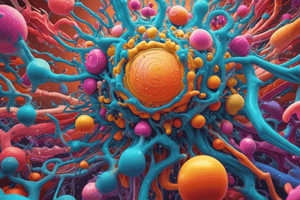Podcast
Questions and Answers
What does the cell membrane control?
What does the cell membrane control?
It controls what enters and exits the cell.
The cell membrane maintains an internal balance called what?
The cell membrane maintains an internal balance called what?
Homeostasis
The cell membrane lets some things in and some things out of the cell. The cell membrane is...?
The cell membrane lets some things in and some things out of the cell. The cell membrane is...?
Selectively Permeable
What are the two types of passive transport?
What are the two types of passive transport?
What is diffusion?
What is diffusion?
What do the particles do in diffusion?
What do the particles do in diffusion?
What is osmosis?
What is osmosis?
Does passive transport go from a high concentration to a low concentration?
Does passive transport go from a high concentration to a low concentration?
Does passive transport use energy?
Does passive transport use energy?
What are the three types of active transport?
What are the three types of active transport?
What is active transport?
What is active transport?
Does active transport use energy?
Does active transport use energy?
Does active transport move from high to low or low to high?
Does active transport move from high to low or low to high?
Does active transport go from a high concentration to a low concentration?
Does active transport go from a high concentration to a low concentration?
What is endocytosis?
What is endocytosis?
What is the process of endocytosis?
What is the process of endocytosis?
What does 'endo' mean?
What does 'endo' mean?
What is exocytosis?
What is exocytosis?
What is the process of exocytosis?
What is the process of exocytosis?
What does 'exo' mean?
What does 'exo' mean?
Active or Passive?
Active or Passive?
Active or Passive?
Active or Passive?
Study Notes
Cell Membrane Functions
- Controls entry and exit of substances in the cell.
- Maintains internal balance known as homeostasis.
- Has a property of being selectively permeable, allowing specific substances to pass.
Transport Mechanisms
- Divided into two categories: passive transport and active transport.
- Passive transport includes diffusion and osmosis.
Passive Transport
- Diffusion: Movement of particles from an area of high concentration to low concentration.
- In diffusion, particles spread out in less crowded areas while still moving.
- Osmosis: Diffusion specific to water, moving from high water concentration to low water concentration.
- Passive transport occurs from high to low concentration without using energy.
Active Transport
- Requires energy to move particles against their concentration gradient (low to high).
- Involves three types: endocytosis, exocytosis, and protein pumps.
- Does not allow movement from high to low concentration.
Endocytosis
- Process of taking in bulky materials by surrounding substances to form a vacuole or vesicle.
- Example: White blood cells engulfing bacteria.
- "Endo" translates to "in."
Exocytosis
- Forcing materials out of the cell in bulk; the vesicle merges with the cell membrane.
- Example: Release of hormones or waste from a cell.
- "Exo" translates to "out."
Energy Use in Transport
- Passive transport does not require energy.
- Active transport requires energy for the movement of substances.
Studying That Suits You
Use AI to generate personalized quizzes and flashcards to suit your learning preferences.
Description
Explore the essential functions of the cell membrane and the various transport mechanisms that facilitate substance movement. This quiz will cover passive and active transport processes, including diffusion and osmosis, and their roles in maintaining cellular homeostasis.




